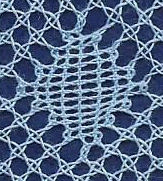

Solid areas are dense areas of lace, used as a contrast to the ground. Click here for different shapes available.

A solid area is worked in rows. Most of the pairs are only used once in a row, and these are described as the passives. For solid cloth stitch and twist, one pair is used for every stitch in the row, and these bobbins are called the workers. The same worker pair travels along the row from beginning to end.
Different lace traditions have different names for these workers, such as walkers, weavers, leaders, and runners. In this website, I shall use "workers".
Working: repeated cloth stitch and twist using the same pair of bobbins across the row. At the end of the row, pin between the workers and the last passives, and tighten. Then repeated work cloth stitch and twist back again.
When working solid areas, you are often dealing with a lot of bobbins between pin and pin, so it often looks a bit of a mess before tightening at the pin. As long as you keep the bobbins in the correct order on the pillow, this should not be a problem. But remember to tighten properly at the pin! The workers change direction here, and if you do not tighten, it may be harder to tighten them later. The passives are not so much on a problem, as they hang straight. The numbers of bobbins involves also means that there is a certain amount of rearranging the bobbins on the pillow.
All solid areas need tightening, but cloth stitch and twist needs more care than usual. All the twists between each stitch means that it is easy tii leave looseness, or even unwanted loops, which will spoil the final result.
Usually solid cloth stitch and twists has workers and passives the same colour. However, since cloth stitch and twist keeps the same worker pair throughout, it is possible to have the workers a different colour. But this type of "solid area" is not really very solid, so it will not colour the shape as much as cloth stitch.
The worker threads travel a greater distance than the passives, since they are involved in every stitch, and the passives are only involved in one stitch per row. This may not matter if the amount of solid cloth stitch and twist is small, and different bits of solid cloth stitch and twist use different workers (which usually happens). However, if you have solid cloth stitch and twist with one pair of workers for the whole piece of lace, such as a zigzag, or fans or diamonds that touch, then you will need to wind on more thread for these workers than for the rest of the bobbins, or they will run out of thread.
Cloth stitch and twist solid areas are rare. Cloth stitch and half stitch are far more common.

Cloth stitch and twist diamond
© Jo Edkins 2020 - return to lace index